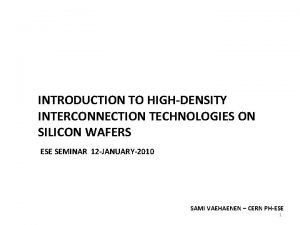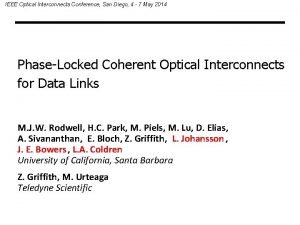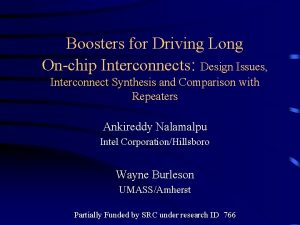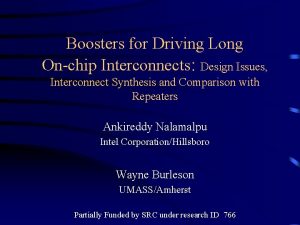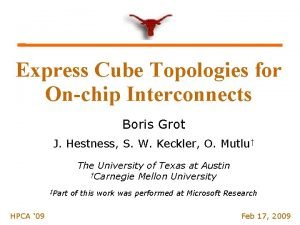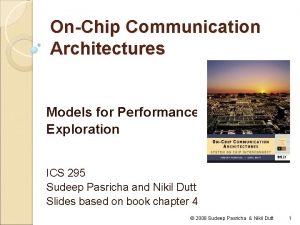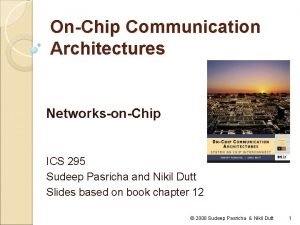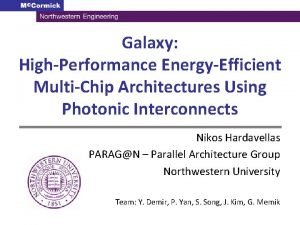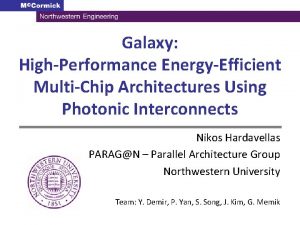OnChip Communication Architectures Physical Design Trends for Interconnects












































- Slides: 44

On-Chip Communication Architectures Physical Design Trends for Interconnects ICS 295 Sudeep Pasricha and Nikil Dutt Slides based on book chapter 11 © 2008 Sudeep Pasricha & Nikil Dutt 1

Outline Introduction DSM Interconnect Design Low Power High Speed Circuit Design Techniques Power Clock 3 D Distribution Techniques Interconnects © 2008 Sudeep Pasricha & Nikil Dutt 2

Introduction Smaller feature size in DSM technology nodes reduces delay of active devices However, effect on delay due to the passive interconnects has increased rapidly Local wire delay decreases with feature size due to a reduction in distance among active devices However overall speed of current ICs is most often limited by the long distance global interconnects © 2008 Sudeep Pasricha & Nikil Dutt 3

Introduction With shrinking feature size and larger chip die dimensions, sheer number of interconnects has increased exponentially Interconnect capacitance often dominates total gate load ◦ therefore, a large portion of the total transient power is dissipated by these on-chip lines ◦ particularly true for those long interconnects that distribute the clock signals that can dissipate 40– 50% of total IC power Gains achieved in performance with technology scaling are often accompanied by an increase in power dissipation ◦ e. g. , additional interconnect layers enhance circuit speed at © 2008 Sudeep Pasricha & Nikil Dutt 4

Introduction Traditionally used RC interconnect models are not sufficiently accurate to properly capture signal propagation in lines with fast transition times Including inductance (L) in the RC model has become a necessary modification ◦ RLC models are therefore becoming increasingly common at the expense of greater computational cost Whether to include inductance in the interconnect model at midrange frequencies (~ 1 - 3 GHz) depends on several factors ◦ e. g. the length of the line, cross-sectional area of the line, etc Under certain conditions, ignoring line inductance may lead to high area and power inefficient circuits © 2008 Sudeep Pasricha & Nikil Dutt 5

Introduction In addition to interconnects among the various onchip devices, the clock and power distribution networks require significant metal resources ◦ both must span the entire chip Accurately modeling the clock, power, and signal nets is a difficult task ◦ highly complex structures Optimally allocating metal to properly design these networks presents an even greater challenge ◦ because of complexity in developing interconnect models © 2008 Sudeep Pasricha & Nikil Dutt 6

Outline Introduction DSM Interconnect Design Low Power High Speed Circuit Design Techniques Power Clock 3 D Distribution Techniques Interconnects © 2008 Sudeep Pasricha & Nikil Dutt 7

DSM Interconnect Design Scaling of the lateral dimensions in planar devices, such as MOS transistors, has produced improvements in device ◦ area ◦ power ◦ speed Power consumption and signal propagation delays of long (global) resistive lines have increased Accurate on-chip interconnect models are required ◦ to determine the signal characteristics and design requirements of high speed DSM interconnect © 2008 Sudeep Pasricha & Nikil Dutt 8

DSM Interconnect Design A local line can be modeled as a single lumped capacitor ◦ signal propagation delay is negligible compared to gate delay Longer lines must include resistive effect Long interconnect models often divide the line into sections - distributed impedance model T or П accuracy depends on no. of sections © 2008 Sudeep Pasricha & Nikil Dutt 9

DSM Interconnect Design Long, wide interconnects operating at frequencies exceeding a GHz are not accurately characterized by an RC model ◦ An RLC model is necessary for accuracy ◦ More complex to evaluate ◦ Distributed RLC model (T or П) © 2008 Sudeep Pasricha & Nikil Dutt 10

DSM Interconnect Design Length criteria for including inductance in interconnect model © 2008 Sudeep Pasricha & Nikil Dutt 11

DSM Interconnect Design Frequency criteria for including inductance in interconnect models ◦ increasing signal frequencies require faster signal transition times ◦ resulting effect of a decreased signal transition time is a lower limit on the line length, making shorter on-chip interconnects behave inductively medium length lines can also behave inductively at high signal frequencies Dielectric material criteria for including inductance in interconnect models ◦ line capacitance can be reduced by half of the capacitance of Si. O 2 with the use of low k dielectrics ◦ copper interconnect has reduced the line resistance by a factor of two to three as compared to aluminum © 2008 Pasricha & Nikil Duttline 12 ◦ these and other new materials further the. Sudeep need to include

Outline Introduction DSM Interconnect Design Low Power High Speed Circuit Design Techniques Power Clock 3 D Distribution Techniques Interconnects © 2008 Sudeep Pasricha & Nikil Dutt 13

Low Power High Speed Circuit Design Techniques High Speed Circuit Design Goal: Improve performance Power and noise are important when considering design techniques to optimize circuit performance Noise affects delay, degrades waveform shape, and most importantly, creates the possibility of an erroneous interpretation of the digital signals © 2008 Sudeep Pasricha & Nikil Dutt 14

CMOS Power Dissipation Overview CMOS Power Dissipation ◦ Dynamic power © 2008 Sudeep Pasricha & Nikil Dutt 15

CMOS Power Dissipation Overview ◦ Short circuit power Due to current flow when a conductive path exists from the power rail to ground rail ◦ Leakage power Due to current that flows between the power terminals in the absence of any switching Increasingly dominating overall power © 2008 Sudeep Pasricha & Nikil Dutt 16

Wire Sizing Width of an interconnect affects the power characteristics and propagation delay Consider a CMOS inverter driving an RC interconnect line ◦ Simple first order model of delay © 2008 Sudeep Pasricha & Nikil Dutt 17

Wire Sizing Increasing the driver transistor width reduces Rtr ◦ decreasing the circuit delay ◦ trading off circuit power and area for higher speed Increasing the width of the interconnect to reduce Rint does not significantly reduce the delay caused by the RC interconnect impedance ◦ since decrease in wire resistance is offset by increase in wire capacitance Many algorithms have been proposed to determine the optimum wire size that minimizes a target cost function ◦ minimizing delay ◦ addressing reliability issues by reducing clock skew Few approaches for simultaneous driver and wire sizing © 2008 Sudeep Pasricha & Nikil Dutt 18

Wire Sizing Tradeoffs exist between dynamic and short-circuit power ◦ As line inductance-to-resistance ratio increases with wider lines, short-circuit power decreases due to reduction in signal transition time ◦ For an RC line, short-circuit power remains approximately constant with increasing width (unlike RLC line shown in figure) decrease in interconnect resistance offset by an increase in capacitance ◦ If width of interconnect exceeds a specific limit, short-circuit power increases change in the matching characteristics between driver and interconnect © 2008 Sudeep Pasricha & Nikil Dutt 19

Driver Sizing Transistor sizing techniques aim to lower delay Wider transistors have a few advantages but also several disadvantages ◦ ◦ ◦ + produce more current + reduce charge time of load capacitance – have greater physical area – have larger gate capacitance – increased circuit area and power A careful balance of the current drive and output load is necessary to enhance circuit performance Power optimal transistor size is smaller than the power-delay optimal transistor size © 2008 Sudeep Pasricha & Nikil Dutt 20

Tapered Buffers An important example of transistor sizing is tapered buffers ◦ Used to drive large capacitive loads Consists of chain of inverters of gradually increasing size Ratio of size of an inverter to size of the preceding inverter is the tapering factor β Delay of tapered buffer system is less than delay of a single large inverter © 2008 Sudeep Pasricha & Nikil Dutt 21

Tapered Buffers Dependence of the tapered buffer propagation delay on tapering factor For minimum delay, optimal number of stages Nopt= ln(M) where M = CL/Co is the ratio of the load capacitance to the input capacitance of the initial inverter in the chain Area, power, and delay strongly dependent on β Trade-offs possible by varying tapering factor © 2008 Sudeep Pasricha & Nikil Dutt 22

Repeater Insertion An effective strategy for reducing delay of a long interconnect is to strategically insert buffers along a line Repeaters circumvent quadratic increase in interconnect delay by partitioning the line into smaller and approximately equal sections Sum of section delays is smaller than delay of original path since delay of each section is reduced Decreased interconnect delay is partially offset by the additional delay of the inserted repeaters © 2008 Sudeep Pasricha & Nikil Dutt 23

Repeater Insertion Optimal number of repeaters Optimal size of repeaters Rt and Ct are the total interconnect resistance and capacitance R 0 and C 0 are the input and output repeater resistance and capacitance Cg 0 is the input capacitance of the repeater Fitting parameters a 1 and a 2 account for rise and fall time of the propagating signal © 2008 Sudeep Pasricha & Nikil Dutt 24

Repeater Insertion For an RC line, repeater insertion techniques outperform wire sizing In RLC lines, wire sizing outperforms repeater insertion as the minimum signal propagation delay with no repeaters is smaller © 2008 Sudeep Pasricha & Nikil Dutt 25

Outline Introduction DSM Interconnect Design Low Power High Speed Circuit Design Techniques Power Clock 3 D Distribution Techniques Interconnects © 2008 Sudeep Pasricha & Nikil Dutt 26

Power Distribution Techniques Power grid consists of a supply, load, and interconnect lines connecting the supply to the load Interconnect lines connecting the power supply to the load are non-ideal with a finite resistance and inductance, ◦ Rp , Lp and Rg , Lg , for the power and ground lines, respectively Change in supply voltages at the© 2008 load terminal is. Dutt Sudeep Pasricha & Nikil 27

Power Distribution Techniques Power supply noise can adversely affect circuit operation Power supply variations reduce rail-to-rail power voltage, causing gate-to-source voltage across both NMOS and PMOS transistors to also decrease ◦ lowering the output drive current of these devices ◦ signal delay increases, compared to delay under nominal power supply voltage Power noise affects propagating clock and data signals by causing an increase in both delay and delay uncertainty within the data paths ◦ severely limit the maximum operating frequency of an IC © 2008 Sudeep Pasricha & Nikil Dutt 28

Power Distribution Techniques Power distribution network should exhibit a minimal impedance at terminals of the load ◦ to ensure a small variation in the power supply voltage Decoupling capacitors ensure correct and reliable operation ◦ distributed across a system, placed at board, package, and onchip levels ◦ provide charge when transient current demands on power grid are high ◦ each decoupling capacitor provides transient current to the load, effectively reducing the local transient noise © 2008 Sudeep Pasricha & Nikil Dutt 29

Power Distribution Techniques On-chip current densities can reach several hundred thousand amperes per sq. cm, leading to electromigration Electromigration is the transport of metal atoms under the force of an electron flux ◦ depletion and accumulation of metal material resulting from atomic flow can lead to formation of extrusions and voids in metal structures ◦ extrusions and voids can lead to short circuits and open circuit faults © 2008 Sudeep Pasricha & Nikil Dutt 30

Outline Introduction DSM Interconnect Design Low Power High Speed Circuit Design Techniques Power Clock 3 D Distribution Techniques Interconnects © 2008 Sudeep Pasricha & Nikil Dutt 31

Clock Distribution Techniques In a synchronous digital system, the clock signal provides a time reference for movement of data within that system Clock signals are typically ◦ loaded with the greatest fanout ◦ travel over the longest distances ◦ operate at the highest speeds of any signal, either control or data Differences in the delay of the clock signals can ◦ severely limit the maximum performance of the entire system ◦ create catastrophic race conditions in which an incorrect data signal may latch within a register © 2008 Sudeep Pasricha & Nikil Dutt 32

Clock Distribution Techniques Synchronous systems are composed of the following three delay components: ◦ memory storage elements ◦ logic elements ◦ clocking circuitry and distribution networks Minimum allowable clock period TCP(min) between any two registers in a sequential data path is © 2008 Sudeep Pasricha & Nikil Dutt 33

Clock Distribution Techniques © 2008 Sudeep Pasricha & Nikil Dutt 34

Clock Distribution Techniques Ideally, clocking events occur simultaneously at all registers Difference in the clock signal arrival time between two sequentially adjacent registers is the clock skew ◦ system-wide or chip-wide clock skew between two nonsequentially adjacent registers, from an analysis viewpoint is meaningless has no effect on the performance and reliability of a synchronous system ◦ can be positive or negative © 2008 Sudeep Pasricha & Nikil Dutt 35

Clock Distribution Techniques Under positive clock skew the maximum attainable operating frequency is decreased ◦ Performance degradation Under negative clock skew maximum performance of a synchronous system can be improved by decreasing delay of a critical path But there is also potential for a race condition ◦ clock skew must be less than the time required for data signal to leave initial register, propagate through interconnect and combinatorial logic, and successfully set up in the final register ◦ if this condition is not met data stored in register Rf is overwritten by data that had been stored in register Ri and has propagated through the combinatorial logic © 2008 Sudeep Pasricha & Nikil Dutt 36

Clock Distribution Techniques The most common strategy for distributing on-chip clock signals is to insert buffers at the clock source and along the clock path, forming a tree structure Buffers, acting as repeaters, are usually distributed throughout clock network Distributed buffers serve the double function of ◦ amplifying clk signals degraded by distributed interconnect impedances ◦ isolating the local clock nets from the upstream load impedances © 2008 Sudeep Pasricha & Nikil Dutt 37

Clock Distribution Techniques Another approach for distributing clock signals utilizes a hierarchy of planar symmetric H-tree or X-tree structures to ensure zero clock skew ◦ by maintaining identical distributed interconnect and buffer paths from clock signal source to the clocked registers ◦ conductor widths in H-tree structures are designed to progressively decrease as signal propagates to lower levels of the hierarchy ensuring that reflections are minimized at branch points Drawbacks compared to standard clock trees: ◦ interconnect capacitance and power dissipation is much greater since total wire length is much longer ◦ difficult to implement in high complexity integrated systems which are typically irregular in nature © 2008 Sudeep Pasricha & Nikil Dutt 38

Outline Introduction DSM Interconnect Design Low Power High Speed Circuit Design Techniques Power Clock 3 D Distribution Techniques Interconnects © 2008 Sudeep Pasricha & Nikil Dutt 39

3 D Interconnects 3 -D interconnects have been proposed as a way to address increasing line delay and capacitive crosstalk Introduction of a third dimension significantly alters distribution of the interconnect length in ICs ◦ As the number of planes is increased, the length and number of the global (local) interconnects decrease (increase) © 2008 Sudeep Pasricha & Nikil Dutt 40

3 D Interconnects It is possible to partition a 2 -D IC into multiple subsections and stack these sections in the vertical dimension ◦ reduces corner-to-corner interconnect length significantly ◦ several global interconnects in the upper metallization levels can be transferred to local, smaller aspect ratio metal layers reduces the total number of metal levels within a 3 -D circuit ◦ an increase in the clock frequency is possible as the worst case data path delay can be reduced assuming a constant number of registers along a sequential data path and number of metal layers ◦ consume less power as compared to 2 -D ICs as a consequence of the reduced capacitive load of the global interconnect lines © 2008 Sudeep Pasricha & Nikil Dutt 41

3 D Interconnects 3 -D interconnect system requires inter-plane interconnects that connect signals between vertically stacked devices Inter-plane interconnects implemented as through silicon vias (TSV) or 3 -D vias can produce the shortest path within a 3 -D system ◦ as compared to wire bonding, peripheral vertical interconnects, and solder ball arrays Much work is needed to properly characterize and model the interplane TSV ◦ primary technological innovation required to exploit benefits of 3 -D integration © 2008 Sudeep Pasricha & Nikil Dutt 42

Summary Complexity of properly designing interconnects in the DSM regime increases with each successive technology generation ◦ Choice between RC or RLC dependant on several factors Low power, high speed circuit techniques are essential to expand battery lifetime and maintain ambient thermal levels ◦ Wire and driver sizing, as well as repeater insertion critical Clock and power distribution are important applications of the general interconnect design problem ◦ noise and skew must be considered during design Novel techniques such as 3 D interconnects in interconnect design can help alleviate challenges in emerging ICs © 2008 Sudeep Pasricha & Nikil Dutt 43

© 2008 Sudeep Pasricha & Nikil Dutt 44
 High-density-interconnection
High-density-interconnection Optical interconnects conference
Optical interconnects conference Product architectures
Product architectures Database and storage architectures
Database and storage architectures Ansi/sparc
Ansi/sparc Switched backbone networks
Switched backbone networks Autoencoders
Autoencoders Theo schlossnagle
Theo schlossnagle Integral architecture example
Integral architecture example Gui architectures
Gui architectures Database system architectures
Database system architectures Cdn architectures
Cdn architectures Aaron bannert
Aaron bannert Independent data mart architecture
Independent data mart architecture Isa computer architecture
Isa computer architecture Browser/server architecture
Browser/server architecture Distributed systems architectures
Distributed systems architectures Backbone network architectures
Backbone network architectures Cache coherence for gpu architectures
Cache coherence for gpu architectures Why systolic architectures
Why systolic architectures La deferred comp
La deferred comp Libidau
Libidau Vcaa visual communication technical drawing specifications
Vcaa visual communication technical drawing specifications Iso 22301 utbildning
Iso 22301 utbildning Novell typiska drag
Novell typiska drag Nationell inriktning för artificiell intelligens
Nationell inriktning för artificiell intelligens Vad står k.r.å.k.a.n för
Vad står k.r.å.k.a.n för Varför kallas perioden 1918-1939 för mellankrigstiden
Varför kallas perioden 1918-1939 för mellankrigstiden En lathund för arbete med kontinuitetshantering
En lathund för arbete med kontinuitetshantering Kassaregister ideell förening
Kassaregister ideell förening Tidbok
Tidbok A gastrica
A gastrica Vad är densitet
Vad är densitet Datorkunskap för nybörjare
Datorkunskap för nybörjare Boverket ka
Boverket ka Hur skriver man en tes
Hur skriver man en tes Delegerande ledarstil
Delegerande ledarstil Nyckelkompetenser för livslångt lärande
Nyckelkompetenser för livslångt lärande Påbyggnader för flakfordon
Påbyggnader för flakfordon Arkimedes princip formel
Arkimedes princip formel Svenskt ramverk för digital samverkan
Svenskt ramverk för digital samverkan Bo bergman jag fryser om dina händer
Bo bergman jag fryser om dina händer Presentera för publik crossboss
Presentera för publik crossboss Argument för teckenspråk som minoritetsspråk
Argument för teckenspråk som minoritetsspråk Bat mitza
Bat mitza
